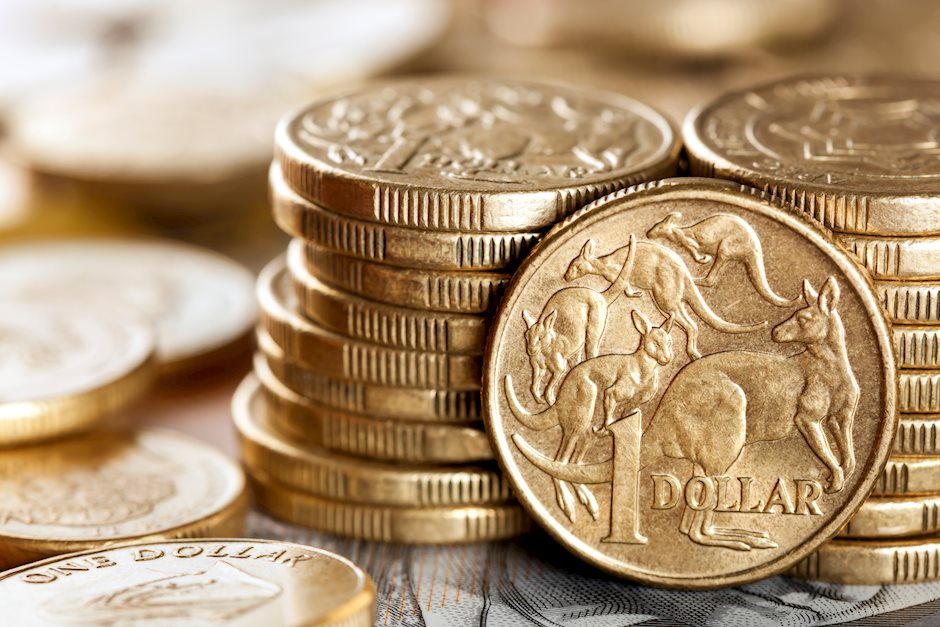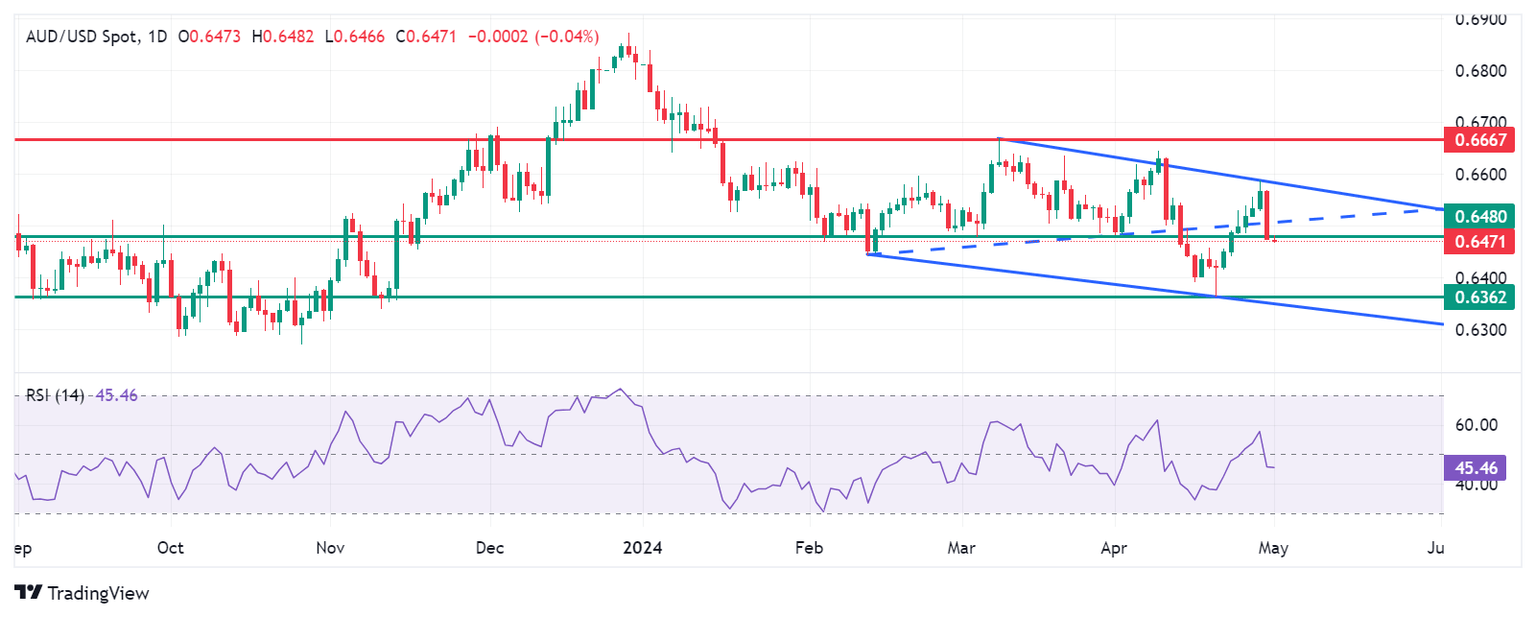Australian Dollar gains ground ahead of Fed interest rate decision
- The Australian Dollar gains ground due to improved risk appetite ahead of the Fed decision.
- The Australian Industry Index indicated prevailing contractionary conditions in private business activity.
- The US Dollar gained after a stronger Employment Cost Index was released on Tuesday.

The Australian Dollar (AUD) has rebounded due to possible risk-on sentiment. However, the AUD/USD pair faced pressure during the early trading hours on Wednesday following the release of the AiG Industry Index. The data indicated a prevailing contraction in private business activity in Australia during March. With the Reserve Bank of Australia’s (RBA) meeting scheduled for next week, it is widely anticipated to maintain interest rates at the current level of 4.35%.
The Australian Dollar lost ground after lower-than-expected Aussie Retail Sales data released on Tuesday, potentially affecting the RBA's hawkish stance on interest rates. However, higher-than-expected domestic inflation data released last week has raised expectations that the central bank may delay interest rate cuts.
The US Dollar Index (DXY), which gauges the performance of the US Dollar (USD) against six major currencies, continues its rally ahead of the US Federal Reserve (Fed) policy meeting scheduled for Wednesday. US bond yields surged following higher-than-expected Employment Cost Index data, further bolstering the USD. Additionally, hawkish remarks from Fed officials, signaling no immediate need for rate cuts, undermined the AUD/USD pair.
Traders are expected to observe the release of the ADP Employment Change and ISM Manufacturing PMI from the United States (US) on Wednesday, ahead of the Fed's Monetary Policy Statement. These releases will likely provide further insights into the state of the United States (US) economy.
Daily Digest Market Movers: Australian Dollar appreciates due to improved risk appetite
- The AiG Australian Industry Index decreased by 3.6 points to hit -8.9 points in April, marking continued contractionary trends over the past two years. March's figure stood at -5.3.
- The ASX 200 began Wednesday trading lower, with all 11 sectors experiencing a decline. This drop followed robust US employment data that rattled Wall Street, raising concerns about sustained inflation and the potential for the US Federal Reserve (Fed) to prolong higher interest rates.
- According to the Financial Review, ANZ predicts the Reserve Bank of Australia will start reducing interest rates in November, spurred by last week's inflation data surpassing expectations. Likewise, Commonwealth Bank, Australia's largest mortgage lender, has revised its forecast for the RBA's first interest rate cut timing, now projecting a single cut in November.
- During the first quarter, the US Employment Cost Index surged by 1.2%, marking the highest increase in a year and surpassing expectations of 1.0% as well as the previous figure of 0.9%. This latest data highlights enduring wage pressures, which could amplify the effects of persistent inflation within the US economy.
- In March, the seasonally adjusted Australian Retail Sales experienced a decrease, failing to meet expectations. This marked the first decline since last December, with turnover decreasing across all industries.
- According to the CME FedWatch Tool, the likelihood of the Federal Reserve maintaining interest rates at their current level during the June meeting has risen to 91.6%, climbing from 81.2% a week ago. This narrative of prolonged higher rates from the Fed could bolster the US Dollar and pose a hurdle for the AUD/USD pair.
- The Economic Times reported on Monday that Fed Chair Jerome Powell mentioned it would likely take "longer than expected" to gain confidence that inflation is progressing towards the central bank's 2% target. Powell added that the central bank can maintain rates at a high level "as long as needed." Fed Governor Michelle Bowman expressed her view of "upside risks" to inflation. Meanwhile, Minneapolis Fed President Neel Kashkari raised the possibility of no rate cuts occurring this year.
Technical Analysis: Australian Dollar moves toward 0.6500
The Australian Dollar traded around 0.6470 on Wednesday. The pair has breached the lower boundary of a symmetrical triangle and the significant level of 0.6480. Additionally, the 14-day Relative Strength Index (RSI) is below the 50-level, indicating a bearish sentiment.
The AUD/USD pair could potentially move toward the vicinity of the psychological level of 0.6400, followed by April's low of 0.6362. A further decline below this level might prompt a test of the lower boundary of the descending channel, around the major level of 0.6350.
If there's an upward movement, the AUD/USD pair might challenge the symmetrical triangle's lower boundary near the psychological level of 0.6500. A breakthrough above this level could bolster the pair to revisit the upper boundary, situated around the level of 0.6585.
AUD/USD: Daily Chart
Australian Dollar price today
The table below shows the percentage change of the Australian Dollar (AUD) against listed major currencies today. The Australian Dollar was the strongest against the Swiss Franc.
| USD | EUR | GBP | CAD | AUD | JPY | NZD | CHF | |
| USD | 0.09% | 0.13% | 0.01% | -0.06% | 0.09% | -0.16% | 0.18% | |
| EUR | -0.10% | 0.03% | -0.08% | -0.15% | 0.02% | -0.25% | 0.09% | |
| GBP | -0.13% | -0.03% | -0.11% | -0.17% | -0.03% | -0.28% | 0.06% | |
| CAD | -0.01% | 0.08% | 0.12% | -0.06% | 0.07% | -0.17% | 0.17% | |
| AUD | 0.06% | 0.14% | 0.17% | 0.06% | 0.13% | -0.11% | 0.22% | |
| JPY | -0.08% | 0.00% | 0.02% | -0.09% | -0.14% | -0.25% | 0.14% | |
| NZD | 0.16% | 0.25% | 0.28% | 0.17% | 0.11% | 0.25% | 0.34% | |
| CHF | -0.19% | -0.09% | -0.06% | -0.17% | -0.24% | -0.10% | -0.34% |
The heat map shows percentage changes of major currencies against each other. The base currency is picked from the left column, while the quote currency is picked from the top row. For example, if you pick the Euro from the left column and move along the horizontal line to the Japanese Yen, the percentage change displayed in the box will represent EUR (base)/JPY (quote).
Australian Dollar FAQs
One of the most significant factors for the Australian Dollar (AUD) is the level of interest rates set by the Reserve Bank of Australia (RBA). Because Australia is a resource-rich country another key driver is the price of its biggest export, Iron Ore. The health of the Chinese economy, its largest trading partner, is a factor, as well as inflation in Australia, its growth rate, and Trade Balance. Market sentiment – whether investors are taking on more risky assets (risk-on) or seeking safe havens (risk-off) – is also a factor, with risk-on positive for AUD.
The Reserve Bank of Australia (RBA) influences the Australian Dollar (AUD) by setting the level of interest rates that Australian banks can lend to each other. This influences the level of interest rates in the economy as a whole. The main goal of the RBA is to maintain a stable inflation rate of 2-3% by adjusting interest rates up or down. Relatively high interest rates compared to other major central banks support the AUD, and the opposite for relatively low. The RBA can also use quantitative easing and tightening to influence credit conditions, with the former AUD-negative and the latter AUD-positive.
China is Australia’s largest trading partner so the health of the Chinese economy is a major influence on the value of the Australian Dollar (AUD). When the Chinese economy is doing well it purchases more raw materials, goods and services from Australia, lifting demand for the AUD, and pushing up its value. The opposite is the case when the Chinese economy is not growing as fast as expected. Positive or negative surprises in Chinese growth data, therefore, often have a direct impact on the Australian Dollar and its pairs.
Iron Ore is Australia’s largest export, accounting for $118 billion a year according to data from 2021, with China as its primary destination. The price of Iron Ore, therefore, can be a driver of the Australian Dollar. Generally, if the price of Iron Ore rises, AUD also goes up, as aggregate demand for the currency increases. The opposite is the case if the price of Iron Ore falls. Higher Iron Ore prices also tend to result in a greater likelihood of a positive Trade Balance for Australia, which is also positive of the AUD.
The Trade Balance, which is the difference between what a country earns from its exports versus what it pays for its imports, is another factor that can influence the value of the Australian Dollar. If Australia produces highly sought after exports, then its currency will gain in value purely from the surplus demand created from foreign buyers seeking to purchase its exports versus what it spends to purchase imports. Therefore, a positive net Trade Balance strengthens the AUD, with the opposite effect if the Trade Balance is negative.
Author

Akhtar Faruqui
FXStreet
Akhtar Faruqui is a Forex Analyst based in New Delhi, India. With a keen eye for market trends and a passion for dissecting complex financial dynamics, he is dedicated to delivering accurate and insightful Forex news and analysis.


















